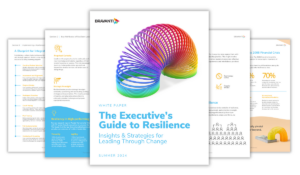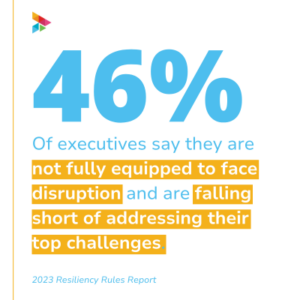 This is part of a series where we examine the role of resilience in individual, team, and organizational success. For a deeper dive, download our latest white paper, The Executive’s Guide to Resilience: Insights & Strategies for Leading Through Change.
This is part of a series where we examine the role of resilience in individual, team, and organizational success. For a deeper dive, download our latest white paper, The Executive’s Guide to Resilience: Insights & Strategies for Leading Through Change.
Most of us will encounter a resilient leader at some point in our careers. Someone who appears to navigate adversity with a calm resolution and skilled finesse that leaves us in awe.
These individuals possess a set of psychological and behavioral traits that likely took many years – and significant effort – to build. And the indelible impact of that resilient leadership is both immediate and lasting, not only on the crisis averted or the opportunity actualized, but in the organizations that employ these leaders and the individuals who bear witness to it.
What is Resilient Leadership?
 The word ‘resilience’ has become a buzzword over the last decade, and with good reason. Analysts estimate that the rate of change has risen by 183% just in the last five years. Surviving in this type of environment (let alone thriving) requires organizational leaders to embody resilience.
The word ‘resilience’ has become a buzzword over the last decade, and with good reason. Analysts estimate that the rate of change has risen by 183% just in the last five years. Surviving in this type of environment (let alone thriving) requires organizational leaders to embody resilience.
Consequently, most people perceive resilient leadership to be a leader’s toughness or capacity to endure hardship. However, it’s far more nuanced than that.
Resilient leadership is the ability to anticipate and adapt to disruptions, quickly recover from challenges, and apply the lessons learned to future strategies. This dynamic process is not just about bouncing back; it’s about evolving through each experience.
Resilient leadership inspires confidence in teams, drives innovation in the face of uncertainty, and steers organizations toward long-term success. It’s the bedrock of performance excellence, where the goal is not merely to survive adversity but to emerge stronger and more capable than before.
18 Key Attributes of Resilient Leaders
Being a resilient leader requires an individual to embody a particular set of traits that collectively equip them with the mindset, knowledge, and experience to respond effectively to the shifting environment around them.
Here are the essential traits of resilient leadership:
1. Pragmatic Idealism
Resilient leaders demonstrate pragmatic idealism, balancing ambitious long-term visions with practical, adaptable approaches to short-term challenges. They are neither strictly idealistic nor merely pragmatic but use a blend of both to respond effectively to evolving circumstances.
2. Paradoxical Thinking
The capacity to hold and manage paradoxes—contradictory yet interrelated elements—is a hallmark of resilient leadership. These leaders thrive by navigating tensions between stability and change, control and empowerment, and tradition and innovation.
3. Perseverance & Courage
Resilient leaders persist through setbacks, steadfastly dedicated to their goals. This tenacity is vital during prolonged challenges, inspiring teams to stay committed and focused despite difficulties. They also recognize that confronting fears, especially of change, is essential for organizational success.
4. Adaptability & Flexibility
Resilient leaders demonstrate adaptability by adjusting strategies to changing conditions, ensuring organizational success in evolving circumstances. They embrace diverse problem-solving methods and adapt plans efficiently, maintaining stability and guiding their teams through uncertainties.
5. Emotional Intelligence & Empathy
Leaders with high emotional intelligence understand and manage their emotions in challenging times. They use empathy to enhance team cohesion, motivating their teams to overcome adversity collectively, while building trust and loyalty.
6. Self-Awareness
Resilient leaders possess a high level of self-awareness that allows them to understand their strengths and weaknesses and how their actions affect others. This attribute is fundamental in managing personal stress and maintaining effective leadership during crises.
7. Purpose & Vision
Resilient leaders maintain a clear, compelling vision even during uncertainty, steering their organizations through challenges without losing sight of long-term goals. They communicate this vision with a sense of purpose and direction, which keeps everyone aligned and motivated.
8. Effective Communication
Resilient leaders prioritize proactive and transparent communication, set clear expectations, and consistently update their teams to minimize uncertainty and build trust. Their ability to actively listen and respond to team concerns fosters inclusive and effective problem solving.
9. Decisiveness
Decisiveness in resilient leadership involves making clear and timely decisions based on available information, enabling their teams to move forward under pressure. This decisiveness prevents stagnation, builds team confidence, and helps mitigate risks effectively.
10. Continuous Learning & Improvement
Resilient leaders have a demonstrated commitment to lifelong learning and improvement. This mindset allows them to view challenges as learning opportunities, and as leaders, helps to foster this same mindset in their teams.
11. Perpetual Curiosity
Leaders with perpetual curiosity continually seek new knowledge and insights, regardless of their level of expertise or success. This trait encourages teams to challenge the status quo and look beyond the obvious for new and better ways of doing things.
12. Data-Driven Decision Making
Resilient leaders know the importance of using data analysis to guide decisions. Leaders who adopt this approach use both historical and real-time data to steer strategies, enhancing efficiency and reducing risks by ensuring decisions are empirically backed.
13. Strategic Foresight
Resilient leaders practice strategic foresight, constantly questioning and reevaluating existing strategies and assumptions. This ongoing process of learning and adaptation allows them to anticipate potential challenges and prepare appropriate responses.
14. Strategic Problem Solving
When challenges arise, resilient leaders approach them strategically, considering both short-term solutions and long-term impacts. They navigate through challenges by analyzing situations deeply and creatively to devise effective strategies.
15. Team Empowerment
Resilient leaders prioritize empowering their teams by delegating authority and encouraging autonomy. This approach leads to greater engagement and trust, stimulates growth, and enhances the team’s ability to adapt to new challenges effectively.
16. Commitment to Core Values
Upholding organizational values while under pressure is a core tenet of resilient leadership. This commitment helps to guide decision making and actions, reinforcing the organizational culture and ensuring alignment during times of change.
17. Trustworthiness
A crucial aspect of resilient leadership is the ability to foster trust in themselves and among their teams. This creates a foundation that enhances collaboration and improves the collective capacity to respond to crises.
18. Equitable & Ethical
Leaders committed to equity and ethics ensure fairness and transparency in their practices. This commitment builds trust, enhances employee satisfaction, and bolsters the organization’s immunity to external disruption.
Tips for Building Leadership Resilience
Step 1: Identify Your Stressors
To build resilience, leaders must first recognize the stressors affecting their performance. This can be done through different practices, including self-reflection, gathering feedback from teams, and conducting environmental scans to anticipate potential disruptions. Once identified, leaders can develop strategies to eliminate the stressors or mitigate their impact.
💡 Pro Tip: Download The Executive’s Guide to Resilience for nine methods for identifying stressors →
Step 2: Establish Resilience Rituals
Resilience rituals are high-performance habits that help leaders maintain focus and regulate emotions during challenging times. These rituals will vary from person to person and can include practices like reflective journaling, mindfulness, regular health checks, and taking breaks to reset and refocus. Incorporating these rituals into daily routines enhances leaders’ ability to process new lessons and maintain mental clarity.
Step 3: Engage in Resilience Coaching
Resilience coaching acts as a catalyst for high-performing leaders, providing the most effective path for building leadership resilience. Through in-depth assessments, targeted development plans, mindset coaching, and ongoing support and guidance, resilience coaching goes beyond surface-level solutions to provide the right mix of resources to accelerate and amplify leaders’ resilience-building efforts.
Step 4: Be Aware of Common Pitfalls
The path to leadership resilience is fraught with obstacles that could negatively impact progress. Whether it’s reverting to familiar but ineffective behaviors, resisting change, neglecting physical and mental health, or any number of other challenges, recognizing and addressing these pitfalls is essential for sustaining resilience over time.
💡 Pro Tip: Discover the 15 most common pitfalls to watch out for in The Executive’s Guide to Resilience →
Step 5: Measure Your Progress
Tracking resilience-building efforts is crucial for ensuring long-term success. To effectively track progress, leaders can use quantitative methods like the Resilience Scale for Adults (RSA) or the Brief Resilience Scale (BRS) as well as qualitative methods like stakeholder feedback sessions. By measuring improvements in leadership effectiveness and resilience levels, leaders can adjust their strategies and maintain momentum.
The Imperative of Resilient Leadership
The importance of resilience in leadership cannot be overstated. Leaders who prioritize resilience not only improve their ability to withstand challenges but also foster a culture of adaptability and growth within their organizations. By demonstrating resilience, these leaders set the tone for their teams, encouraging a mindset that views obstacles as opportunities for innovation and improvement.
As business environments become increasingly complex, resilient leaders will be the ones who thrive. They will lead with confidence, transforming disruption into momentum and ensuring that their organizations remain not just competitive but ahead of the curve.
Investing in resilience is not a short-term fix; it’s a long-term strategy for sustained leadership excellence.
Ready to build your individual, team, and organizational resilience? Book a free consulting session to get started today!
Be the first to discover our latest resources!
👉 Subscribe to our monthly newsletter
Additional resources for building resilience:
[White Paper] The Executive’s Guide to Resilience
The Relationship Between Change & Resilience
Episode 3: Are You Thriving or Surviving? Resilience & Managing Your Energy with Ragini Basu
You’re Leading Others… How Are You Leading Yourself?
Building Emotional Intelligence in Leaders

